|
|
![]()
FOREST HEALTH - SOFTWOOD ROOT DISEASES
Roots are vulnerable to many soil borne fungi especially when trees are weakened by drought, insect attack, and other stess agents. Usually root diseases are not easily seen, as roots are underground. The above-ground symptoms are noticed and sometimes not connected with root disease. Root disease can affect a seemingly random individual tree, or can kill entire areas (especially in plantation environments). Of course, it's important to remember that many soil fungi are beneficial to trees. Those that develop symbiotic relationships with roots are called mycorrhizae. Some mychorrhizae are essential to tree health and vigor.
Heterobasidion Root Disease |
||
| Heterobasidion root disease (Heterobasidion irregulare): not common in the U.P. but can be a deadly disease in well-managed red pine plantations, Annosum is a problem in parts of Wisconsin, small dead pockets in stands appear and expand, recently cut stumps and tree wounds vulnerable to wind-borne spores, can spread through root grafts, formerly known as Fomes annosus and Heterobasidium annosus. Fruiting bodies diagnostic. | ||
| Hosts: most conifers but especially pines | ||
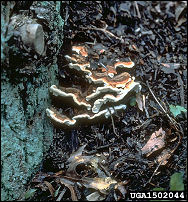 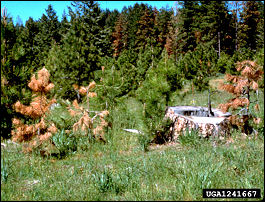 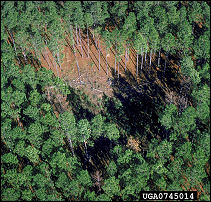 |
||
Damping-off disease (Several genera): particularly an issue in nurseries and young plantations, spores reside in soil especially with wet and alkaline (pH > 5.5) conditions, stem is killed at root collar |
||
| Hosts: most conifers, as well as hardwoods | ||
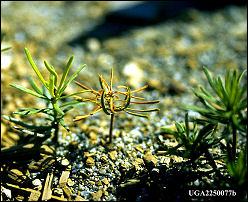 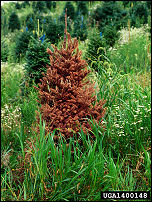 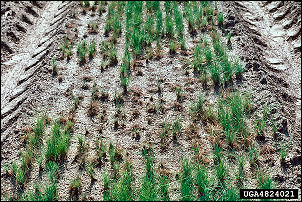 [Fusarium spp., Phytophthora spp., Rhizoctonia solani] |
||
Dye Maker's Polypore (Phaeolus schweinitzii): produces the brown cubical rot common to many conifers, can extend far underground from the butt, conks can be found on tree butt or growing out of the ground |
||
| Hosts: pines, spruces | ||
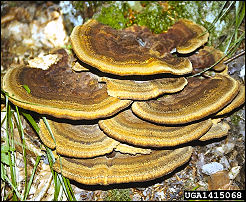 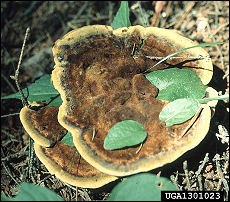 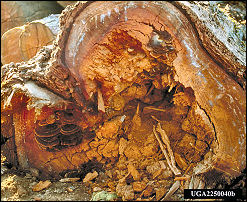 |
||
| Red Pine Pocket Disease (Leptographium spp.): not known (yet) in the U.P. but has been documented across much of Wisconsin. Small mortality pockets grow progressively. Blue stain characteristic in newly-killed red pine. Associated with certain bark beetles. | ||
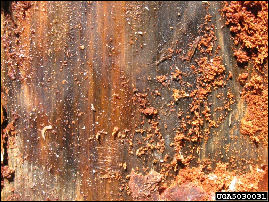 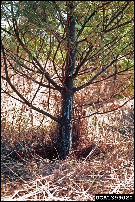 |
||
| Hosts: thinned red pine | ||
Tomentosus Root Rot (Onnia tomentosus or Inonotus tomentosus): common, can extend 10 feet up the trunk, whitish rot pockets within browning wood, a honeycomb appearance |
||
| Hosts: white pine, spruces | ||
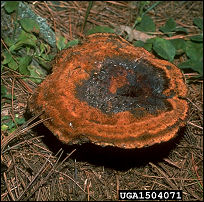 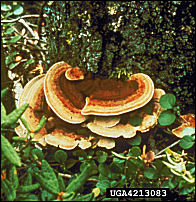 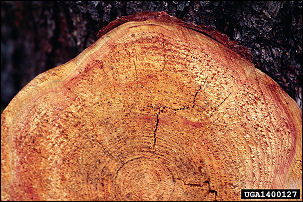 |
||
Image Citations
Annosum root rot (1) - USDA Forest Service - Region 8 - Southern Archive, Bugwood.org
Annosum root rot (2) - USDA Forest Service Archive, USDA Forest Service, Bugwood.org
Annosum root rot (3) - John W. Schwandt, USDA Forest Service, Bugwood.org
Annosum root rot (3) - USDA Forest Service - Pineville Archive, USDA Forest Service, Bugwood.org
Damping-oiff disease (1) - USDA Forest Service Archive, USDA Forest Service, Bugwood.org
Damping-oiff disease (1) - Linda Haugen, USDA Forest Service, Bugwood.org
Damping-oiff disease (1) - Edward L. Barnard, Florida Department of Agriculture and Consumer Services, Bugwood.org
Dye-Maker's Polypore (1) - Andrej Kunca, National Forest Centre - Slovakia, Bugwood.org
Dye-Maker's Polypore (2) - Joseph O'Brien, USDA Forest Service, Bugwood.org
Dye-Maker's Polypore (3) - USDA Forest Service Archive, USDA Forest Service, Bugwood.org
Red pine pocket disease (1) - Joe O'Brien, USDA Forest Service, Bugwood.org
Red pine pocket disease (2) - Manfred Mielke, USDA Forest Service, Bugwood.org
Tomentosus Root Rot (1) - USDA Forest Service - Region 8 - Southern Archive, USDA Forest Service, Bugwood.org
Tomentosus Root Rot (2) - Minnesota Department of Natural Resources Archive, Minnesota Department of Natural Resources, Bugwood.org
Tomentosus Root Rot (3) - Linda Haugen, USDA Forest Service, Bugwood.org
Click HERE
to return to the U.P. Tree ID home page.
Click HERE to return to the Forest Health home page.
This site created and maintained by Bill Cook, MSU Extension Forester for the Upper Peninsula of Michigan. Editing and modification is ongoing. Submit suggestions, questions, and corrections to cookwi@msu.edu or call 906-786-1575.